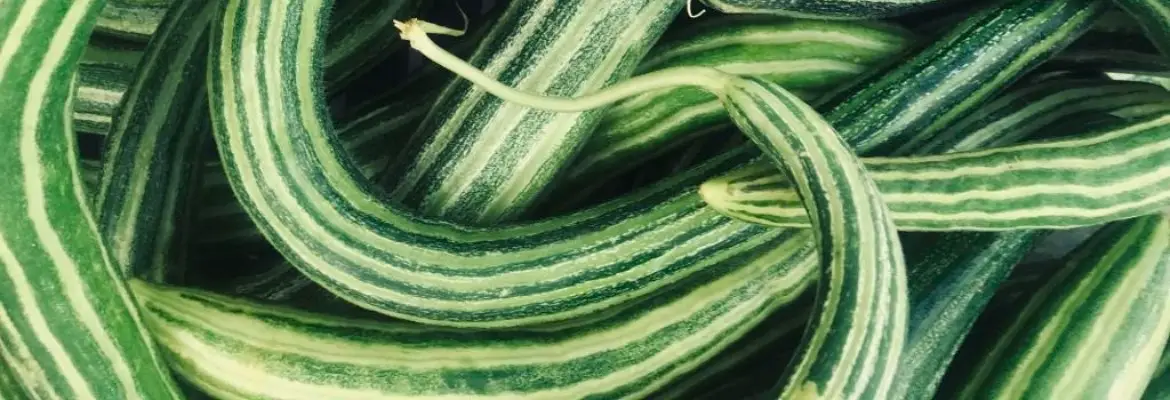It is common throughout the world to use the words “gourds” and “squashes” interchangeably, so the Snake Squash is also known as Snake gourd.
Growing on climbing vines, this tropical vegetable thrives in warm climates. Snake squashes have a tendency to curl as they grow; to make them grow straight, trellises and weights need to be placed at the end of the vegetable.
Long and curved, snake squash has green skin with white stripes. Despite its ability to grow to 1.8 meters in length, the best time to harvest snake gourd is when it is in its young state. The ideal harvest length of snake gourd can be between 30-60 cm.
Snake squashes have white, spongy flesh that is similar to zucchini. It has a bland taste and its texture allows it to absorb the taste of the seasoning when cooked. Also, depending on the snake gourd variety, the taste may be mildly bitter at first. However, the bitter taste will fade after cooking.
It is best to eat young snake gourds because they become bitter and fibrous as they mature.
Snake gourd is rich in fiber, niacin, thiamine, riboflavin, vitamin A, calcium, potassium and iron.
Scientific name of Snake Gourd
Trichosanthes Cucumerina
Other names of Snake Gourd
- Serpent Gourd
- Chichinda
Nutrition facts of Snake Gourd
*Serving size = 100 grams = 3.55 Ounces = 1/2 cup
*DV= % Daily Value (%DV indicates how much nutrients contribute to a person’s daily diet from a serving of a food. DV assists you in determining whether or not a serving of food is high or low in a particular nutrient.)
| Nutrient | Amount | Unit |
|---|---|---|
| Calories | 12 | KCAL |
| Fat | 0.25 | GRAM |
| Protein | 0.89 | GRAM |
| Carbohydrate | 1.23 | GRAM |
| Fiber | 2.27 | GRAM |
Calories by source in Snake Gourd:
- Calories by carbohydrate in Snake Gourd = 53%
- Calories by fat in Snake Gourd = 10%
- Calories by protein in Snake Gourd = 37%
Fats and Fatty Acid profile of Snake Gourd:
- Polyunsaturated fat (PUFA) in Snake Gourd = 50%
- Saturated fat (SFA) in Snake Gourd = 48%
- Monounsaturated fat (MUFA) in Snake Gourd = 2%
Detailed vitamin profile of Snake Gourd, vitamin A, vitamin B12, vitamin B6, vitamin C, vitamin D, Folate, Niacin, Thiamin, and Riboflavin is shown in the chart at the end of the article.
Detailed mineral profile of Snake Gourd, Sodium(Na), Calcium(Ca), Copper(Cu), Iron(Fe), Magnesium(Mg), Selenium(Se), Phosphorus(P), Potassium(K) and Zinc(Zn) is shown the chart at the end of the article.
Availability of Snake gourd
- Snake gourd / snake squash is available round the year
Complete nutrition facts of Snake Gourd
Click on the link HERE to download high quality, high resolution and print ready PDF version of the Snake Gourd nutrition chart/infographic.



